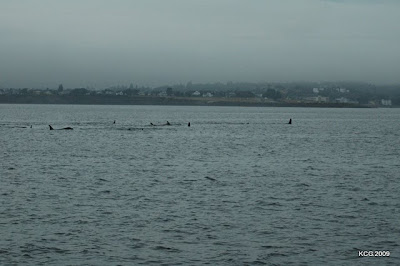Sighting #1: 'Resident' fish eating killer whales (Orcinus orca)
Time: 0916
Start location: right off Beacon Hill Park, Victoria waterfront
End location: 0.5 miles west of Trial Island/Enterprise Channel
Pods and Individuals identified:
Pods and Individuals identified:
J - J1, J2, J8, J14, J30, J37, J40?, J45, J17, J28, J35?, J44, J16, J42, J33, J36, J26, J34, J19, J41
K - K21, K40, K11, K20, K38?, K25?, K26
L - L12, L85, L22, L92, L90, L87, L89, L26, L7, L53, L25
Cool killer whale fact: Like all cetaceans, killer whales are voluntary breathers and are “half awake” when they are resting. Their brain has the ability to split activities; half will 'sleep' while the other half controls breathing and mobility (Lyamin et al. 2008 paper abstract)
Links
Center for Whale Research killer whale fact page, photo ID and matrilines
Orca Adoption Program at Friday Harbour Whale Museum
Orcasound online hydrophone network
Orca Sightings Network
American Cetacean Society fact sheet

J1, Ruffles, and J2, Granny, estimated born in 1911...these two are probably the oldest members of the Southern Resident community

Huge milling Southern Resident group off the Victoria waterfront with the cruise ships at Ogden Point in the background

L77, Matia, a 22 year old female (1st from left), L53, Lulu, a 32 year old female (2nd from left)and J14, Samish, a female estimated to be born in 1974 (fourth from left) within a group of the Southern Residents

Above 2 photos: large group of Southern Residents tight and travelling slowly off the Victoria waterfront
Sighting #2: Humpback whale (Balaenopter acutorostrata)
Time: 1044
Location: 1 mile East of Race Rocks in the Strait of Juan De Fuca
Behaviour: probably foraging, no direction
Cool humpback whale fact: The humpback whale is one of the rorquals, a family that also includes the blue whale, fin whale, Bryde's whale, sei whale, and minke whale. Rorquals take their name from the Norwegian word röyrkval, meaning "furrow whale". All members of the family have a series of longitudinal folds of skin running down their throats.
Links
American Cetacean Society humpback whale fact sheet
Department of Fisheries and Oceans humpback catalogue











No comments:
Post a Comment